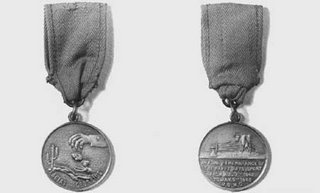
The George Medal is legendary among 1st Marine Division veterans of Guadalcanal. Only about 50 were cast, in Australia, before the mold gave out.
The medal commemorates the difficult situation of the division during the early days on Guadalcanal, when ammunition, food, and heavy equipment were short and the Japanese plentiful. When the issue was no longer in doubt, Marine had time to reflect on the D-plus-3 Navy withdrawal in the face of increasing Japanese air attacks and surface action which left the division in such a tight spot.
In the recollection of then-Captain Donald L. Dickson, adjutant of the 5th Marines, the Division G-3, then-Lieutenant Colonel Merrill B. Twining, resolved to commemorate the occasion. Twining told artist Dickson in general terms what he had in mind. Dickson went to work designing an appropriate medal using a fifty-cent piece to draw a circle on a captured Japanese blank military postcard.
Dickson's design was approved and when the division got to Australia a mold was made by a local metal craftsman and a small number were cast before the mold became unserviceable. Those wanting a medal paid one Australian pound for it and received a certificate as well. The medals are now an even greater rarity than at the time. In recent years, reproductions have been cast, and can be identified by the different metal and a poor definition of details.
The obverse design shows a hand and sleeve dropping a hot potato in the shape of Guadalcanal into the arms of a grateful Marine. In the original design the sleeve bore the stripes of a vice admiral intended to be either Vice Admiral Robert L. Ghormley, ComSoPac, or Vice Admiral Frank Jack Fletcher, Commander Joint Expeditionary Force, but the final medal diplomatically omitted this identification.
Also on the obverse is a Saguaro cactus, indigenous to Arizona, not Guadalcanal, but representing the code name for the island, "Cactus." The obverse inscription if Facia Georgius, "Let George Do It." Thus it became known as the George Medal.
The medal's reverse pictures a cow (the original design showed a Japanese soldier with breeches down) and an electric fan, and is inscribed: "In fond remembrance of the happy days spent from Aug. 7th 1942 to Jan. 5th 1943. U.S.M.C."
The suspension ribbon was made, appropriately, of the pale green herringbone twill from some Marine's utility uniform. Legend has it that to be authentic the utilities from which the ribbons were made had to have been washed in the waters of Guadalcanal's Lunga River. Some medals were provided with the oversized safety pin used to identify laundry bags in Navy shipboard laundries.
Such unofficial commemorative mementos are not uncommon in military circles and recall, among other, the Soochow Creek medals recognizing the defense of Shanghai's International Settlement during the Japanese invasions of 1932 and 1937 which were inspired by the Military Order of the Dragon medals of veterans of the China Relief Expedition or Boxer Rebellion. —Brooke Nihart
l
No comments:
Post a Comment